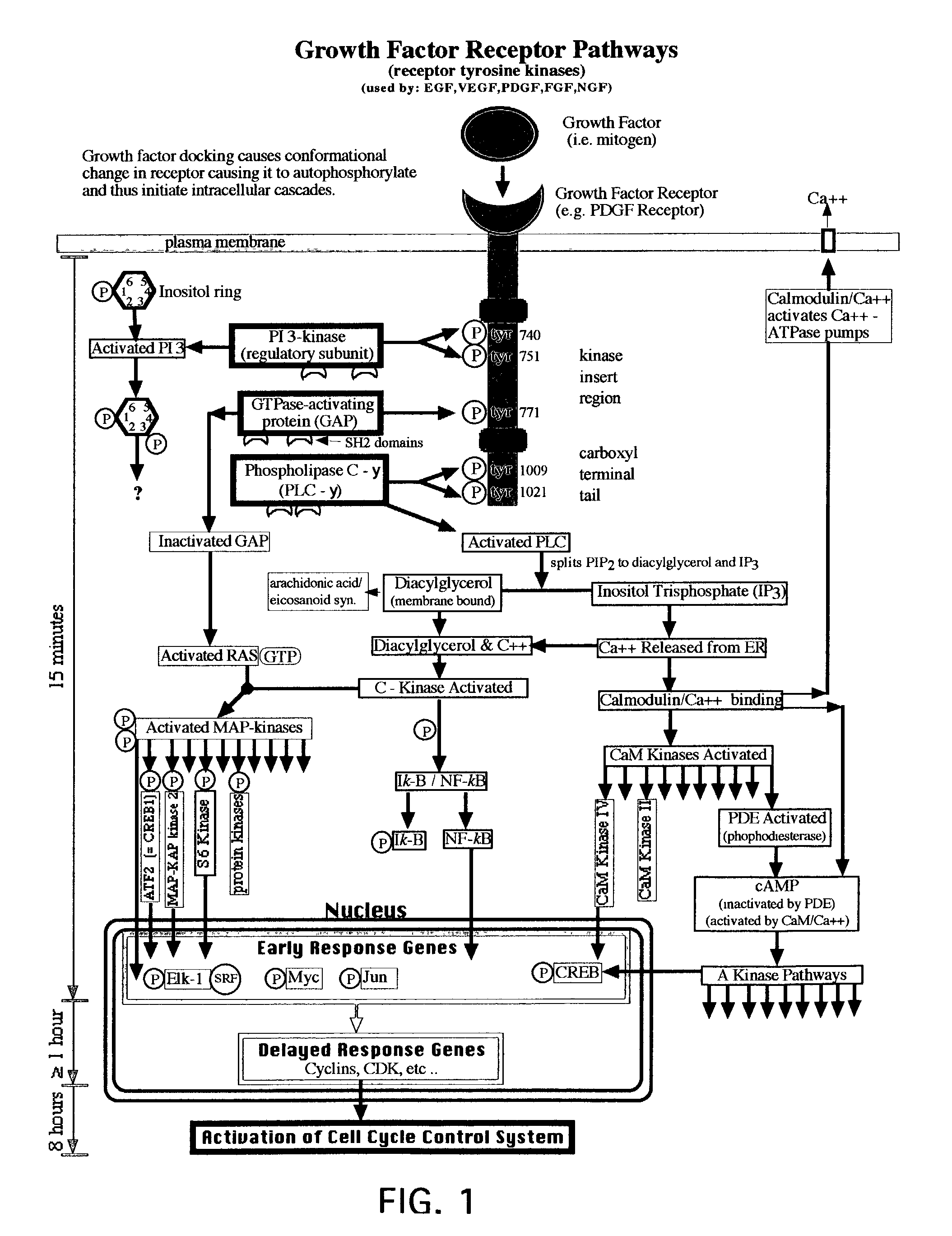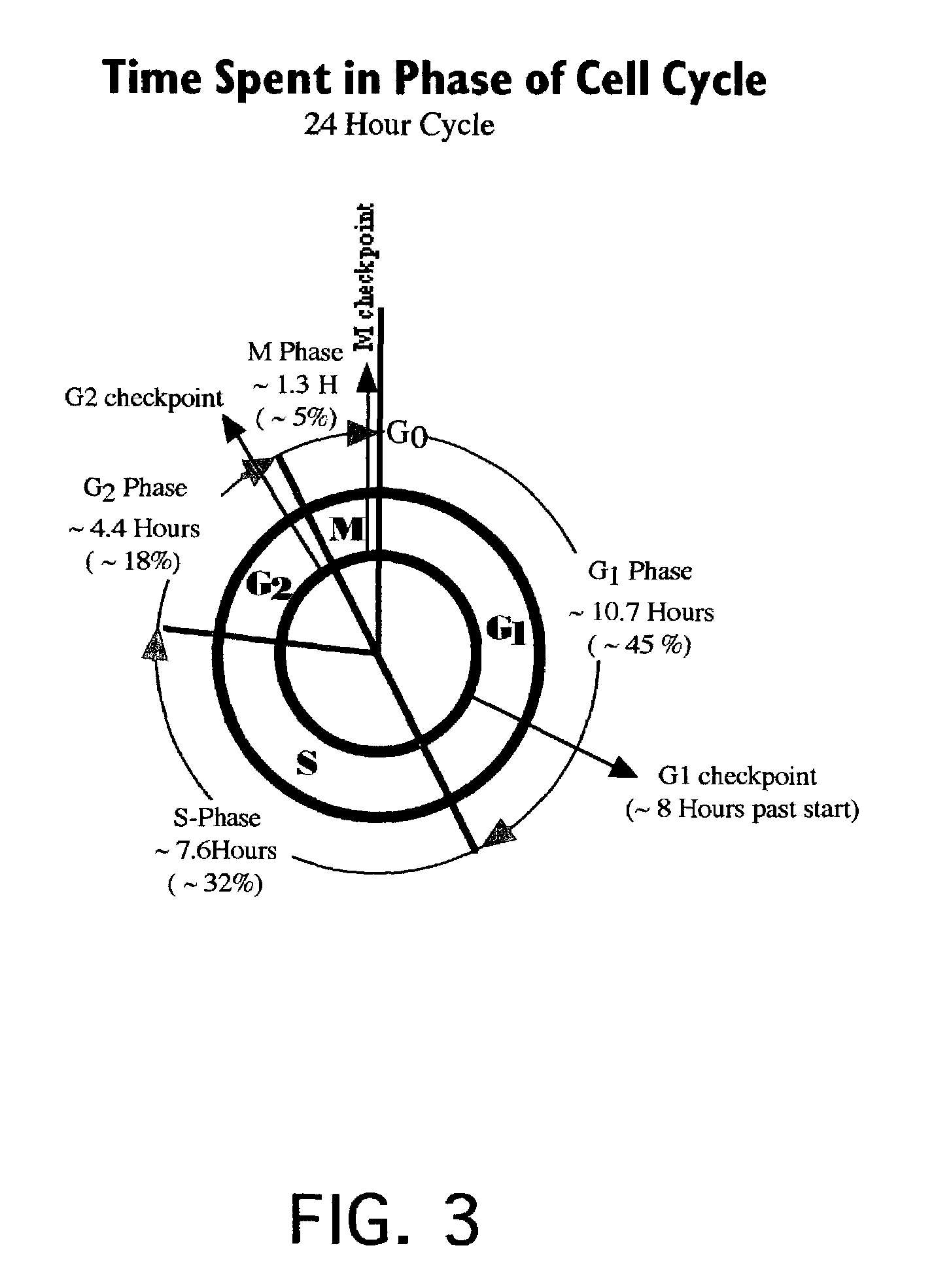HER cancer protocols
a cancer and protocol technology, applied in the field of cancer protocol, can solve the problems of increased tumor cell kill, less suitable dose escalation agents, and urgent need for curative chemotherapeutic regimens, and achieve the effects of reducing tumor size, reducing the number of cytotoxic administrations, and reducing the number of tumors
- Summary
- Abstract
- Description
- Claims
- Application Information
AI Technical Summary
Benefits of technology
Problems solved by technology
Method used
Image
Examples
example 1
Single Tumor
[0076]A patient presents with a 2 cc inoperable tumor in the lung. It is determined the cancer has a 3+ level of HER2 overexpression as measured by prior art immunohistochemical assessment methods.
[0077]The cancer cells are determined to have a 4 day cell cycle rate below the 1 cc level and 20 days above the 1 cc level (e.g. a biopsy of the cancer cells cultured in vitro reveals the 4 day cycle, MRI, CAT, PET or other imaging method taken some time apart reveal increase in tumor size corresponding to a 20 day rate, or any other suitable method of determining cell cycle time may be substituted.)
[0078]Under prior art, an S-Phase cytotoxic would cause genotoxic damage to cells in the S-Phase, and as the reach the G2 checkpoint they are removed. The surviving cells find themselves in a much more favorable environment and accelerate their growth up to 5 times faster (i.e. 4 day cycle) until they recrowd and are once again nutrient limited to a 20 day cycle according to the Go...
example 2
Multiple Tumors
[0100]Several months after surgical removal of an 8 cc lung cancer mass, the patient presents with metastatic lung cancer, with a 2 cc tumor in the lung, a 1 cc tumor in the liver, a 0.5 cc tumor in the kidney and it is suspected there are one or more undetected metastatic sites where the tumor is too small to be detected yet. It is determined the cancer has a 3+ level of HER2 overexpression as measured by prior art immunohistochemical assessment methods.
[0101]The cancer cells are determined to have a 4 day cell cycle rate below the 1 cc level and 20 days above the 1 cc level (e.g. a biopsy of the cancer cells cultured in vitro reveals the 4 day cycle, MRI, CAT, PET or other imaging method taken some time apart reveal increase in tumor size corresponding to a 20 day rate for the larger tumors and / or 4 days for the small one, or any other suitable method of determining cell cycle time may be substituted.)
Conforming Regimen for Example 2:
[0102]Under present invention, O...
example 3
Multiple Large Tumors
[0114]The patient presents with a non endocrine dependent 5 cc tumor in the lung, a 3 cc tumor in the liver, a 1 cc tumor in the kidney and it is suspected there are one or more undetected metastatic sites where the tumor is too small to be detected yet. It is determined the cancer has a 3+ level of HER2 overexpression as measured by prior art immunohistochemical assessment methods. The cancer cells are determined to have a 4 day cell cycle rate below the 1 cc level and 20 days above the 1 cc level.
Conforming Regimen for Example 3:
[0115]Under present invention two sweeps are required for the conforming regimen to insure all cells are at the fastest cycling rate prior to chemotherapy.
[0116]First Sweep: On day 0 and day 6, a high S-Phase kill rate cytotoxic chemo (e.g. 100 mg / m2 of irinotecan, 150 mg / m2 etoposide, or other suitable S-Phase chemotherapeutic) is administered. On day 3.5, a intravenous infusion loading dose of 4 mg / kg of the cytostatic agent Trastuzu...
PUM
| Property | Measurement | Unit |
|---|---|---|
| time | aaaaa | aaaaa |
| time | aaaaa | aaaaa |
| survival time | aaaaa | aaaaa |
Abstract
Description
Claims
Application Information
 Login to View More
Login to View More - R&D
- Intellectual Property
- Life Sciences
- Materials
- Tech Scout
- Unparalleled Data Quality
- Higher Quality Content
- 60% Fewer Hallucinations
Browse by: Latest US Patents, China's latest patents, Technical Efficacy Thesaurus, Application Domain, Technology Topic, Popular Technical Reports.
© 2025 PatSnap. All rights reserved.Legal|Privacy policy|Modern Slavery Act Transparency Statement|Sitemap|About US| Contact US: help@patsnap.com



